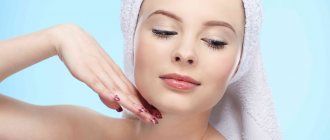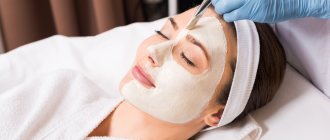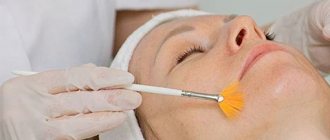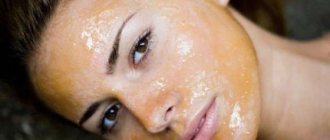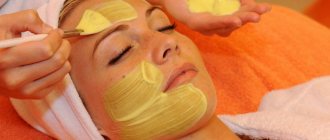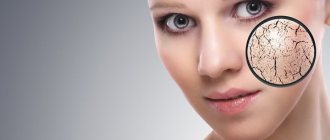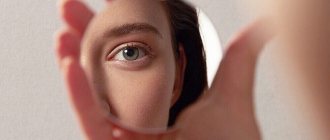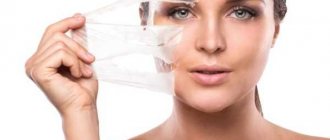Most professional cosmetologists will say that combining yellow peeling and pregnancy is undesirable. But on specialized aesthetic forums, information is often found that expecting a baby or planning a pregnancy is not a contraindication to retinoic exfoliation and such a “neighborhood” is possible. Especially in the early stages of pregnancy or on the eve of its onset. Let's figure out why retinol is not safe for the fetus, how long before pregnancy you need to stop visiting a beauty salon, why pregnant women run the risk of complications, and when you can resume skin rejuvenation with retinoic peeling.
The benefits and harms of the retinol component for pregnant women
Retinol is the main component of yellow (retinol, retinoic) peeling; during pregnancy, it can have both beneficial and harmful effects on the body of the expectant mother and child. In small doses, this vitamin is beneficial, but its excess can have adverse consequences.
Retinol has the ability to rapidly accumulate in tissues and organs, especially in the liver; for this reason, its dosage must be carefully monitored during pregnancy.
The benefit is as follows: this vitamin takes an active part in the synthesis of red blood cells. Blood cells transport oxygen and nutrients to tissues. Thanks to this, the fetus receives the optimal amount of microelements.
Retinol promotes the proper formation of important systems:
- cardiovascular;
- respiratory;
- bone;
- circulatory
Vitamin A is needed for proper development:
- organs of vision;
- brain and spinal cord;
- kidney
The substance provides support for a woman’s immunity during pregnancy and protects against pathogenic microorganisms. Retinol accelerates the regeneration of epidermal cells, which plays an important role during the recovery period after childbirth.
But even a slight excess of the dosage is fraught with the risk of premature aging of the placenta and the development of pathologies in the fetus. Approximately 2-3 months before planning a pregnancy, you need to abandon procedures aimed at rejuvenating the skin if retinol is used during them. This also applies to taking complexes containing this vitamin.
We recommend: Features of chemical peeling for the face. Pros and cons of the procedure, rules of preparation and conduct
Excess retinol in the body of a pregnant woman leads to damage to the internal organs of the fetus. The ones who suffer the most are:
- child's limbs;
- heart;
- reproductive and nervous systems;
- kidneys
Excessive amounts of retinol entering the body reduce the effect of vitamin D and provoke its deficiency.
Effect on the embryo
Doctors are of the opinion that retinoids have a teratogenic effect, they negatively affect the process of fetal formation and provoke developmental pathologies.
For this reason, professionals from the beauty industry are trying to find out whether a woman has pregnancy plans in the near future and whether she is breastfeeding.
There are no scientifically proven facts that retinol, which penetrates into the body of the expectant mother from peeling preparations, provokes mutations in the fetus. But it was found that retinoic acid molecules have the ability to penetrate cell membranes and contact proteins in the cell nuclei. This process does not affect the transport of genetic chains from the mother to the baby’s body.
The amount of retinoic acid in the peel may not be enough to transform the genetic code.
Tests on the effects of retinoids on the fetus were performed exclusively on mice in laboratory conditions. No facts have been found to prove the teratogenic effect of vitamin A and its artificial analogues.
Pregnant women have never been tested for fetal pathologies under the influence of retinoic acid. For this reason, pregnancy and lactation are included in the list of contraindications for yellow peeling. In this case, doctors play it safe.
Retinol (yellow) facial peeling: everything you wanted to know
Content
Dermatocosmetologist Victoria Britko explained why “yellow” peeling cannot be done in the summer, what contraindications exist for it, and why the procedure cannot be performed when planning a pregnancy.
Educational program
The word “peeling” is translated from English as “scraping.” In cosmetology, the procedure is used to solve many problems: eliminating age spots, preventing age-related changes, renewing the surface layer of the skin, eliminating hypersecretion of the sebaceous glands, and others. After a course of peelings, the production of collagen and elastin is stimulated (read more about youth proteins here) - skin turgor improves, traces of post-acne disappear, and complexion becomes more even. Cosmetologists classify them according to depth and method of exposure.
Short course in physiology
Before we talk about the features of the “yellow” peeling, a short course in physiology.
The outer layer of skin is called the epidremis. It acts as a protective barrier and carefully “monitors” that “uninvited guests” do not enter the body.
The epidermis is regularly renewed - its cells are constantly dividing, and keratinized particles are exfoliated. Between the epidermis and the next layer, the dermis, is the basement membrane. This is another barrier to everything “foreign”.
The dermis (the skin itself) is a framework of collagen and elastin fibers, the space between which is filled with hyaluronic acid and cells. Its main functions are: trophic, supporting and metabolic. The dermis has two layers: papillary and reticular. Below the dermis is the subcutaneous fatty tissue (or hypodermis).
That's all you need to understand how peels work.
Depending on the depth of impact, they are divided into: superficial - work at the level of the epidermis, middle - penetrate into the dermis, working on the synthesis of collagen and elastin, deep - are carried out exclusively in an operating room.
Superficial peels (almond, glycolic) can be done even in summer, provided the skin is protected from ultraviolet radiation.
Retinol peeling: what, where, when?
Retinol peeling belongs to the category of chemical procedures based on vitamins - it is most popular in clinics and beauty salons. To carry it out, retinolic acid is used, a synthetic analogue of vitamin A.
Indicated for serious skin defects: scars, scars, post-acne, as well as enlarged pores and increased greasiness of the skin. After the procedure, the skin peels heavily for about a week, so peeling can be done only in the autumn-winter period to avoid pigmentation.
The acid activates the process of cell renewal, providing a rejuvenating effect, and also acts as a “catalyst” for the production of elastin, tightening the skin (read the link for which products prolong youth).
To achieve maximum effect, “yellow” peeling is recommended to be done in courses - up to four procedures per season.
Important! Retinol enters the bloodstream and remains active for up to 6 months. This is absolutely safe for the female body, but if you are planning a pregnancy, give preference to another type of peeling - “yellow” can cause fetal malformations.
There are other contraindications to the procedure: lactation period, individual intolerance to components, cancer, acne, active herpes.
The rehabilitation period after retinol peeling lasts about a week. On the third day, the skin begins to actively peel off. It is strictly forbidden to touch or tear it off - scars may form.
Sometimes there may be slight swelling. There is no need to panic - this is normal! To quickly cope with peeling, you can use moisturizing creams with hyaluronic acid and oils in the composition, driving them in with your fingertips.
And don't forget about SPF! Protection must be used every day before going outside. Physical activity, visiting the solarium, baths and saunas are prohibited during the rehabilitation period.
Negative effects on the mother's body
A pregnant woman may develop an allergy after a yellow peeling procedure. A similar reaction is caused by components in peeling products.
Important! If a woman still decides to undergo this procedure, despite her situation, she must undergo an allergy test.
A drop of the product is applied to the wrist or the inner bend of the elbow. Usually an allergy, if any, appears after a quarter of an hour. The absence of itching or redness means that the peeling product will not cause an allergic reaction.
We recommend: What is coral facial peeling, how is it done and what is the care after the procedure?
In addition to allergies, a woman during pregnancy may experience headaches due to an excess amount of retinol in the body. Other negative consequences include:
- swelling;
- liver dysfunction;
- fragility of hair and nails.
Cost of the procedure
- Procedures
| procedure | price |
| Yellow (retinoic) peeling procedure (face) YELLOW PEEL | 4 500 |
| Yellow (retinoic) peeling procedure (face, neck, décolleté) YELLOW PEEL | 8 000 |
| Keratoregulating peeling procedure Renophase | 2 600 |
| Classic almond peeling procedure | 2 400 |
| Almond peeling procedure MANDELAC 40% gel | 1 900 |
| Whitening peeling procedure | 2 800 |
| Renophase reprogramming peeling procedure | 2 900 |
Content:
Retinol peeling
Indications and contraindications for peeling
Pros of yellow peeling
Procedure
Retinol peeling is characterized by minimal skin damage and possible complications. Also, this peeling has a short recovery period: its results become noticeable immediately after the procedure.
The active form of retinol is called retinoic acid. Retinoic acid works not only with skin cells, but also with cells throughout the body. Therefore, in order to avoid unwanted effects on other parts of the body in the functioning of internal organs, cosmetologists use special masks with a high content of the active component.
A mask with retinol is used once every 1-2 weeks. After the first peeling session, patients usually experience severe peeling of the skin. However, this is a natural process of active skin renewal, which passes quite quickly. After just 1-1.5 months (that is, after 4-5 peeling sessions), the skin becomes smooth, elastic and toned. With the help of medical creams, this effect can be achieved after six months.
Is it possible to use retinol when planning conception?
Combining yellow peeling and planning conception is also not recommended. It is worth considering other options for solving skin problems.
Doctors believe that the procedure using drugs that contain retinol is not as dangerous at the stage of pregnancy planning as at the stage of gestation. But it is important to remember that the risk of developing pathologies in the fetus under the influence of retinol can be completely eliminated only by completely abandoning such cosmetic manipulation.
Aggressive facial cleansing done in the weeks before pregnancy can cause miscarriage or premature birth. Other types of peeling are allowed at the planning stage.
Attention! At the stage of preparation for motherhood, avoid any aggressive effects on the epidermis. For those who want to successfully carry and give birth to a healthy baby, it is better not to take risks.
How long after the procedure can you not become pregnant?
A course consisting of 4–6 peeling sessions using products containing retinol forms a vitamin reserve in the skin; it lasts for about 3 months.
During this time, the epidermis will contain retinoic acid molecules, which promote visual rejuvenation.
The effect of yellow peeling lasts longer than other procedures aimed at skin rejuvenation that have a superficial effect.
For a normal pregnancy after yellow peeling, at least three months must pass before the planned conception.
If a woman is going to get pregnant and soon become a mother, she should refrain from retinoic exfoliation and replace the procedure with another one, for example, multi-fruit or milk peeling.
We recommend: Home peeling from Victoria Boni. Cooking recipe and procedure features
Opinion and advice of cosmetologists
Cosmetologists do not recommend doing yellow peeling during pregnancy. This procedure should also be avoided during lactation.
Doctors advise avoiding cleansing your face in this way even at the stage of pregnancy planning. Experienced professionals usually refuse to perform this procedure on clients expecting the birth of a child.
But this does not mean that pregnant women should refuse to visit a cosmetologist altogether. The specialist will recommend another procedure that will tidy up your facial skin without harming the fetus.
It is undesirable for pregnant women to undergo retinoic exfoliation. This cosmetic procedure has many advantages, but there are also side effects. During pregnancy, it is better not to take risks and postpone it for several months.
Yellow exfoliation and pregnancy
During pregnancy, yellow peeling is undesirable for several reasons.
Risks to fetal development
Despite the lack of evidence on the tetragenic nature of retinol and its synthesized analogues, as well as on the systemic effect of the drug and its accumulation in the blood plasma, it is better for pregnant women to refuse yellow exfoliation sessions. Especially in the second or third trimester of pregnancy. In the early stages, the contact between the mother and the embryo has not yet been formed, because the common vascular network is just beginning to form. In any case, you need to warn the cosmetologist in advance that you are expecting a baby.
Mom's allergies
The body of a pregnant woman may respond with an allergic reaction to the components of the retinoic peel. Therefore, if you nevertheless decide in favor of such exfoliation, while you are pregnant, ask your cosmetologist to conduct an allergy test before the peeling session. To do this, apply a drop of the product to the thin skin of the wrist, the inner bend of the elbow or behind the ear. An atypical reaction will appear within 10-15 minutes. If itching or redness does not appear, the peeling preparation will not cause allergies.
Possibility of side effects
During pregnancy, the peeling procedure can go wrong. Firstly, because the expectant mother’s body is sensitive to external influences and unfamiliar odors. Secondly, because pregnancy is a time of hormonal changes in the female body. Changing hormone levels may cause unexpected pigmentation, pimples, or redness to appear after a peel.
The decision to perform yellow peeling on the eve of or during pregnancy is made by each woman independently. Of course, most cosmetologists will not undertake a retinoic procedure knowing that the client is pregnant. But some young ladies in the weather prefer to keep silent about it for beauty reasons. Considering specialists’ doubts about the “harmlessness” of retinol and its safety for the normal formation of the fetus, it is still better to warn the specialist about the planned conception or pregnancy before the exfoliation session.
